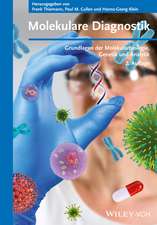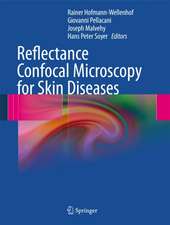Signal Transduction in Affective Disorders
Editat de Hiroki Ozawa, Toshikazu Saito, Naohiko Takahataen Limba Engleză Paperback – 6 mar 2012
| Toate formatele și edițiile | Preț | Express |
|---|---|---|
| Paperback (1) | 361.23 lei 6-8 săpt. | |
| Springer – 6 mar 2012 | 361.23 lei 6-8 săpt. | |
| Hardback (1) | 368.19 lei 6-8 săpt. | |
| Springer – 31 dec 1997 | 368.19 lei 6-8 săpt. |
Preț: 361.23 lei
Preț vechi: 380.25 lei
-5% Nou
Puncte Express: 542
Preț estimativ în valută:
69.14€ • 71.91$ • 57.94£
69.14€ • 71.91$ • 57.94£
Carte tipărită la comandă
Livrare economică 13-27 martie
Preluare comenzi: 021 569.72.76
Specificații
ISBN-13: 9784431684817
ISBN-10: 4431684816
Pagini: 160
Ilustrații: 146 p.
Dimensiuni: 155 x 235 x 8 mm
Greutate: 0.23 kg
Ediția:Softcover reprint of the original 1st ed. 1998
Editura: Springer
Colecția Springer
Locul publicării:Tokyo, Japan
ISBN-10: 4431684816
Pagini: 160
Ilustrații: 146 p.
Dimensiuni: 155 x 235 x 8 mm
Greutate: 0.23 kg
Ediția:Softcover reprint of the original 1st ed. 1998
Editura: Springer
Colecția Springer
Locul publicării:Tokyo, Japan
Public țintă
ResearchDescriere
Recent progress in brain science has been remarkable, especially with regard to advances in the area of neuroscience. Particularly in the past decade, there have been many important discoveries about signal transduction in the brain. With this background, biological research in affective disorders has become well developed in relation to neural signaling. However, this field is fairly hard to understand comprehensively, and there is relatively little integrative work with clinical psychiatry in spite of the involvement of a wide variety of scien tific disciplines. This monograph brings together up-to-date reviews from several young Japanese scientists who work in basic and clinical neuroscience. The intention is to explain in plain language the information that has evolved on signal transduction in terms of the biological abnormalities and mechanisms of anti depressants. The model shown on the cover (and on page 24) is intended to help the reader understand signal transduction in the brain and the patho physiology of affective disorders as well as the mechanisms of antidepressants.
Cuprins
Effects of Antidepressants on Transmembrane Signaling.- Role of G Proteins in Signal Transduction.- Effects of Chronic Administration of Antidepressants on Signal Transduction.- The Phospholipase C System in Affective Disorders.- Targets for Antidepressants.- References.- Serotonergic and Noradrenergic Neuromodulation in the Hippocampus and the Mechanism of Action of Antidepressants.- Pathophysiological Model of Affective Disorders and Monoaminergic Function.- Development of Novel Antidepressants and Their Pharmacological Profiles.- Modulation of Serotonergic Neurotransmission by SSRIs.- Convergence of Serotonergic and Noradrenergic Neurotransmission: Neurodynailiic Viewpoint.- Conclusion.- References.- Serotonin-2A Receptor Function in Affective Disorders.- Role of 5-HT2A Receptor Function in Etiology of Affective Disorders.- Postmortem Brain Studies.- Neuroendocrine Studies.- Platelet Studies.- Calcium Mobilization and Affective Diosorders.- 5-HTMnduced Calcium Response in Nonmedicated Depressed Patients.- Change in 5-HT-Induced Calcium Response During Drug Treatment.- Other Calcium Studies.- Mechanism of 5-HT2A Receptor Hyperfunction.- Conclusion.- References.- Immunological Aspects of Mood Disorders: Interaction Between Cytokines and Intracellular Calcium Signaling.- Immunological Dysfunction in Mood Disorders.- Stress and Immunological Function.- Alteration of Immune Function and Mood.- Cytokines and Nitric Oxide Pathway.- Cytokines and Calcium Function.- Conclusion.- References.- The Role of G Proteins in the Pathophysiology and Treatment of Affective Disorders.- Changes in the Biological Hypotheses for the Pathophysiology of Manic-Depressive Illness.- Antidepressants and G Proteins.- Receptors and G Proteins.- G Protein and Adenylyl Cyclase.- Direct Action on G Protein.- Receptor Reconciliation Theory of the Action of Antidepressants.- Postmortem Study in Affective Disorders.- Postnatal Developmental Changes of G Protein in Human Brains.- Imbalance Hypothesis of G-Protein Function in Affective Disorders.- Selectivity of Treatment Drugs in the Light of Signal Transduction.- Conclusion.- References.- Protein Phosphorylation System in the Mechanism of Action of Antidepressants.- Protein Phosphorylation Systems.- cAMP-Dependent Phosphorylation System.- Effect of Antidepressant Treatment on the PKA System.- Effect of Antidepressant Treatment on Phosphorylation of Substrate Proteins for PKA.- Effect of Antidepressant Treatment on Phosphorylation of MAP2.- Effect of Antidepressant Treatment on Microtubule Assembly.- Conclusion.- References.- Stress and BDNF Signal Transduction: Implications for Stress-Related Psychiatric Disorders.- Physiological Functions of BDNF.- Regulation of BDNF Expression.- BDNF Signal Transduction Cascade.- Stress-Induced Hippocampal Cellular Damage.- Stress and BDNF.- Co-Administration of a Phosphodiesterase Inhibitor and the Response to Selective Norepinephrine Reuptake Inhibitor.- Conclusion.- References.- Postreceptor Signal-Transduction Systems as Potential Targets of Lithium.- Lithium and Postreceptor Signal-Transduction.- Phosphoinositide Metabolism.- Adenylyl Cyclase System.- G Proteins.- Protein Phosphorylation and Gene Expression.- Conclusion.- References.- Participation of Cytoskeletal Elements in Neuronal Signal Transduction: New Insight into the Molecular Basis of Antidepressant Action.- Tubulin, G Proteins, and Adenylyl Cyclase Signal Transduction.- Tubulin - G Protein Interaction.- Cytoskeletal Elements and Antidepressant Drugs.- References.- In Vivo Investigations of Signal-Transduction Systems in Affective Disorders by Magnetic Resonance Spectroscopy.- Which Metabolites in Signal-Transduction Systems Can Be Measured by MRS?.- Neurotransmitters.- Second Messengers.- Phosphoinositide System.- Other Phospholipases.- Cyclic AMP.- Clinical Applications of MRS to the Study of Signal-Transduction Systems.- Phosphoinositide System.- Choline.- Lipids.- Conclusion.- References.
Caracteristici
Brings up-to-date reviews by young scientists who work actively in basic and clinical neuroscience.









